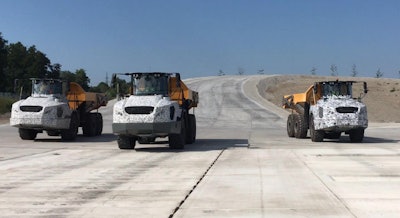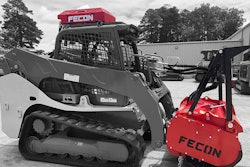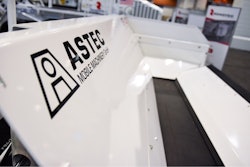 Liebherr’s prototype articulated dump trucks at its Kirchdorf, Germany, testing facility.
Liebherr’s prototype articulated dump trucks at its Kirchdorf, Germany, testing facility.Liebherr will put its new 30-ton articulated dump trucks in its company rental fleet starting next year and make the unit—the TA230—available for sale to European end users in 2021. North American users are expected to see it for the first time in 2021, when it will be available in dealer rental fleets.
The company says it will expand its lineup to include a 40- and 45-ton model, to be introduced at the 2022 Bauma show.
Liebherr showcased its ongoing articulated dump truck development at a press event last week in Kirchdorf, Germany.
Werner Seifried, managing director research and development at Liebherr-Hydraulikbagger, highlighted several of the simulation and prototype tests the company has used to develop its ADT line.
As detailed in the video below, Equipment World received an up-close look at Liebherr’s test vehicles, including one outfitted with the semi-autonomous controls.
“The top priority is producing the first prototype vehicle to the highest possible standard in terms of its quality and functionality,” Seifried says.
The company used simulation models, virtual reality and avatars to aid its ADT development. Virtual reality, for example, was used to examine operator field of vision for such operations as tipping the body and steering the unit left and right. And an avatar was used to simulate replacing a tire.
Data gained by the simulation models and other tests formed the basis of creating prototype iron, which is now undergoing final tests at Liebherr’s development and demonstration center, opened in 2018 at Liebherr’s Kirchdorf plant.
Knowing that ADTs can operate in extreme environments, Liebherr set about designing a test rough-road track to use to simulate a 15,000-hour machine life. Testing was accelerated since a single shift 7-hour test would take around 10 years to complete.
“As you can imagine, the loads which the test drivers experience in these applications are immense for the human body,” says Seifried. Drivers can only work up to 30 minutes depending on the track and load before they have to take a several hour break. The human factor also meant that full test speeds could not be consistently maintained even within that 30-minute window.
Because of this, Liebherr turned to a partially-autonomous test unit, controlled by operators in a tower overlooking the test track. Liebherr calls this unit a “driving robot,” and emphasizes that it is not fully autonomous. The track is separated from the rest of the test site and test vehicles are not equipped with environmental recognition or a collision warning system.
The test track uses several ground profiles in addition to a climbing hill:
- Patched asphalt (target reference speed of about 25 mph)
- Light washboard with an amplitude level of around 2 inches (target reference speed of 10 mph)
- In-phase “Mengen” grooves with a depth of 16 inches (target reference speed of 7 mph)
- Out-of-phase “Benningen” distortion with a depth of 16 inches (target reference speed of 5 mph).
ADT prototypes with at least 100 hours on them are also being field tested by select customers.
Seifried says Liebherr’s ADT development milestones have been successfully completed. “There are no longer any obstacles to the successful start of series production and a long and successful product life,” he says.













